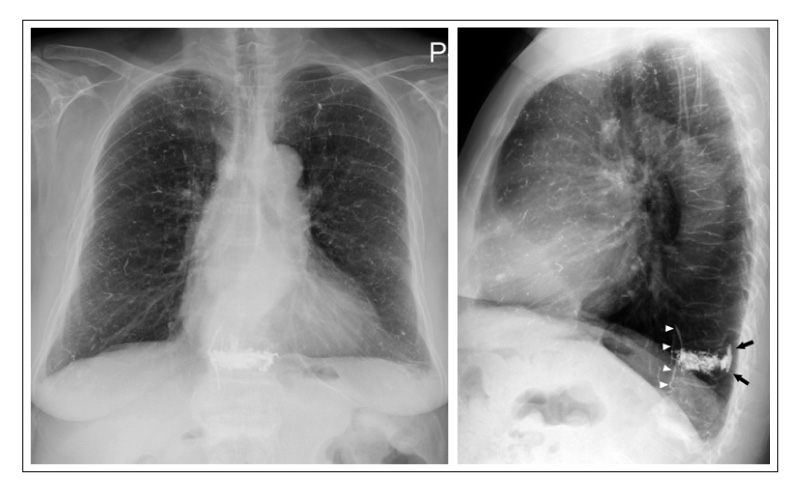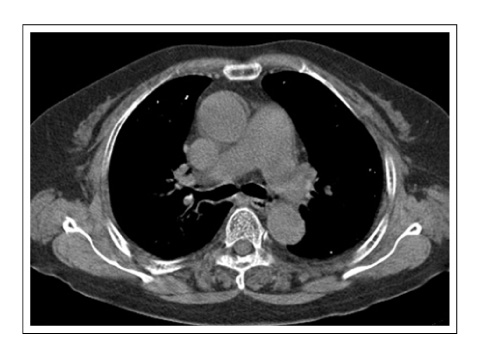Tuberc Respir Dis.
2006 Aug;61(2):184-188.
Numerous Bilateral Radiographically Dense Branching Opacities after Vertebroplasty with Polymethylmethacrylate
- Affiliations
-
- 1Department of Internal Medicine, Ulsan University Hospital, University of Ulsan College of Medicine, Ulsan, Korea. jjahn@uuh.ulsan.kr
- 2Department of Thoracic and Cardiovascular Surgery, University of Ulsan College of Medicine, Ulsan, Korea.
- 3Department of Radiology, Ulsan University Hospital, University of Ulsan College of Medicine, Ulsan, Korea.
Abstract
- Percutaneous vertebroplasty consists of the percutaneous injection of polymethylmethacrylate (PMMA) cement into a collapsed vertebral body in order to obtain pain relief and mechanically strengthen the vertebral body. This procedure is now extensively used in treating osteoporotic vertebral compression fracture. It is an efficient treatment, but it is not free of complications. Most complications after vertebroplasty are associated with PMMA leakage. Pulmonary embolism of PMMA is rare, but this can occur when there is a failure to recognize venous migration of cement early during the procedure. We encountered a case of a patient with asymptomatic pulmonary embolism because of PMMA after percutaneous vertebroplasty. Chest X-ray and CT scanning revealed numerous tubular branching opacities that corresponded to the pulmonary vessels at the segmental and subsegmental levels.
MeSH Terms
Figure
Reference
-
1. Verlaan JJ, Oner FC, Dhert WJ. Anterior spinal column augmentation with injectable bone cements. Biomaterials. 2006. 27:290–301.2. Laredo JD, Hamze B. Complications of percutaneous vertebroplasty and their prevention. Skeletal Radiol. 2004. 33:493–505.3. Padovani B, Kasriel O, Brunner P, Peretti-Viton P. Pulmonary embolism caused by acrylic cement: a rare complication of percutaneous vertebroplasty. Am J Neuroradiol. 1999. 20:375–377.4. Amar AP, Larsen DW, Esnaashari N, Albuquerque FC, Lavine SD, Teitelbaum GP. Percutaneous transpedicular polymethylmethacrylate vertebroplasty for the treatment of spinal compression fractures. Neurosurgery. 2001. 49:1105–1114.5. Choe DH, Marom EM, Ahrar K, Truong MT, Madewell JE. Pulmonary embolism of polymethyl methacrylate during percutaneous vertebroplasty and kyphoplasty. AJR Am J Roentgenol. 2004. 183:1097–1102.6. Barragan-Campos HM, Vallee JN, Lo D, Cormier E, Jean B, Rose M, et al. Percutaneous vertebroplasty for spinal metastases: complications. Radiology. 2006. 238:354–362.7. Seo JS, Kim YJ, Choi BW, Kim TH, Choe KO. MDCT of pulmonary embolism after percutaneous vertebroplasty. AJR Am J Roentgenol. 2005. 184:1364–1365.8. Yoo KY, Jeong SW, Yoon W, Lee J. Acute respiratory distress syndrome associated with pulmonary cement embolism following percutaneous vertebroplasty with polymethylmethacrylate. Spine. 2004. 29:E294–E297.9. Jung KW, Ko YH, Kim HC, Wi JS, Moon JM, Chun BJ, et al. A case of fatal pulmonary embolism caused by bone cement after percutaneous vertebroplasty. J Korean Soc Emerg Med. 2003. 14:121–124.10. Choi Y, Han HC, Lim KJ. Pulmonary embolism after percutaneous vertebroplasty with polymethymethacrylate. J Korean Pain Soc. 2002. 15:190–193.11. Jang JS, Lee SH, Jung SK. Pulmonary embolism of polymethylmethacrylate after percutaneous vertebroplasty: a report of three cases. Spine. 2002. 27:E416–E418.12. Park CB, Yi MZ, Kim SD, Joo SJ, Yeo YS, Hong MK, et al. Acute pericarditis caused by penetrated polymethylmethacrylate of the right ventricle after percutaneous vertebroplasty. Korean J Med. 2004. 67:528–531.
- Full Text Links
- Actions
-
Cited
- CITED
-
- Close
- Share
- Similar articles
-
- Hypotension during Percutaneous Vertebroplasty with PMMA (Polymethylmethacrylate)
- Pulmonary Embolism after Percutaneous Vertebroplasty with Polymethylmethacrylate: A case report
- Pulmonary Embolism after Percutaneous Vertebroplasty with Polymethylmethacrylate: Case Report
- Neurologic Complication after Percutaneous Vertebroplasty with Polymethylmethacrylate: A Case Report
- The Analysis of Polymethylmethacrylate Leakage after Vertebroplasty for Vertebral Body Compression Fractures






